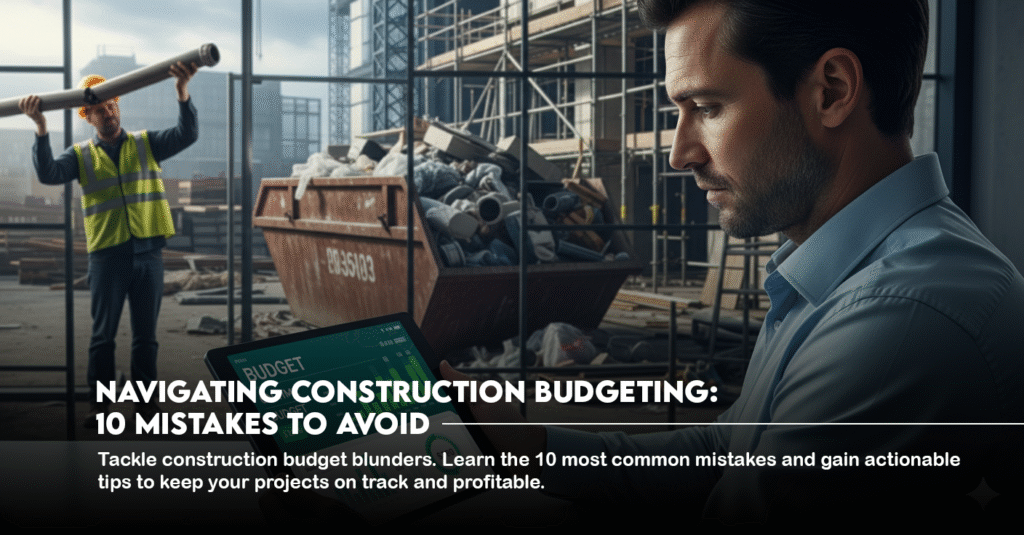Mistake 1: Rushing the Pre-Construction Phase
This is where projects are won or lost before the first shovel even hits the dirt. Many teams, eager to start, skimp on the critical planning and estimation phase.
- The Problem: You’re racing to win a bid, so you rely on rough estimates instead of detailed analysis. You may have an incomplete understanding of site conditions, permit requirements, or the full scope of the client’s vision. This leads to a budget built on assumptions, not facts.
- The Consequence: Unrealistic estimates from the start create an unrealistic final budget. When you encounter the inevitable surprises be it a utility line you didn’t know was there or a more complex foundation than you planned for you have no financial cushion. The entire project is on the back foot from day one.
- The Fix: Slow down to speed up. Invest time and resources in comprehensive pre-construction planning. Conduct detailed site assessments, talk to the local municipality about permits and regulations, and get all stakeholders to sign off on a crystal-clear project scope. Use historical data from similar projects to ground your initial estimates in reality.

Mistake 2: Ignoring “Soft Costs” and Indirect Expenses
Most contractors are great at budgeting for hard costs like labor and materials. But many forget about the expenses that aren’t directly related to the physical build.
- The Problem: You have a detailed list of materials and labor, but what about the project manager’s salary? What about the cost of design fees, engineering studies, permits, insurance premiums, and temporary utilities? These costs are often overlooked or lumped together into a generic, insufficient category.
- The Consequence: Soft costs can account for a significant portion of a project’s total budget, sometimes as much as 20% or more. Failing to budget for them means that these expenses will eat away at your profit margin as they accumulate. It’s like a thousand small leaks in your financial pipeline.
- The Fix: Create a detailed checklist for both hard and soft costs. Treat soft costs with the same rigor as you do materials and labor. Track them, report on them, and allocate a specific budget for each. This ensures every expense, no matter how small, has a home in your budget.
Mistake 3: Inadequate Contingency Funds
Every project has surprises. A contingency fund is your safety net, but many contractors either don’t have one or make it too small.
- The Problem: You build a tight budget with no buffer, hoping everything will go perfectly. Or, you allocate a minimal 2-3% because you want to keep your bid as low as possible to win the job.
- The Consequence: When an unexpected issue arises like a sudden rainstorm delaying work for a week or a piece of equipment breaking down you have no way to cover the costs without digging into your profit or, worse, asking the client for more money. This damages your credibility and can strain client relationships.
- The Fix: As a rule of thumb, set aside at least 5-10% of your total project budget for contingencies. For high-risk, complex projects, this percentage should be even higher. A well-managed contingency fund shows foresight and professionalism.
Mistake 4: Poor Change Order Management
Scope creep is the silent project killer. It happens when new requirements are added without a formal, documented process to account for the additional time and cost.
- The Problem: The client asks for a seemingly small change, and you agree to it verbally. Then another change comes up, and another. Before you know it, the original scope is unrecognizable, and your team is doing extra work with no budget to show for it.
- The Consequence: This is a direct path to cost overruns and project delays. Every undocumented change eats into your budget and can lead to confusion and disputes with the client. It erodes your profitability one request at a time.
- The Fix: Establish a clear and formal change order process from the very beginning. Every single change, no matter how small, must be documented. The document should detail the new scope, the impact on the budget, and the effect on the timeline. Get all stakeholders to sign off on it before any work begins. This protects both you and the client.
Also Read: Should Contractors Use AI for Estimating? Pros and Cons Explained
Mistake 5: Lack of Real-Time Cost Tracking
Are you still using spreadsheets that are updated once a week, or worse, once a month? If so, you’re flying blind.
- The Problem: You’re not tracking your budget vs. actuals in real-time. By the time you realize you’re over budget on a particular task, it’s already too late. You can’t make proactive decisions; you can only react to a problem after it has already occurred.
- The Consequence: Small cost overruns on individual tasks can accumulate into a project-wide financial disaster. You lose control of the budget and can’t make timely adjustments to reallocate resources or cut unnecessary spending.
- The Fix: Adopt modern, integrated construction management software. These platforms allow you to track every expense as it happens, giving you a live, up-to-the-minute view of your financial health. Empower your project managers and foremen with dashboards that show them exactly where the project stands financially.
Mistake 6: Unrealistic Labor Cost Estimates
Labor is often the single biggest expense on a project, and getting it wrong can be catastrophic.
- The Problem: You underestimate the number of hours a task will take, the wage rate for skilled labor, or the amount of overtime needed to stay on schedule. You might not account for benefits, payroll taxes, or travel time.
- The Consequence: This leads to a massive gap between your estimated and actual labor costs. This is an especially dangerous mistake on fixed-price contracts, where you are responsible for covering all overruns.
- The Fix: Break down labor costs by specific task and role. Use historical data to get accurate hour estimates for similar jobs. Communicate with your subcontractors and foremen to get realistic feedback on what’s achievable. Always factor in non-wage costs like taxes and insurance.
Mistake 7: Failing to Account for Market and Seasonal Fluctuations
The price of materials and the availability of labor are not static.
- The Problem: Your budget is based on today’s prices, but the project will last for six months. You don’t account for potential price hikes in key materials due to supply chain issues or seasonal demand. For example, lumber prices can soar in the spring and summer.
- The Consequence: Your initial, competitive bid is suddenly no longer profitable. You’re forced to absorb the increased costs, which can wipe out your entire profit margin on a job.
- The Fix: Research market trends and factor in inflation, especially for long-term projects. Use estimating software that connects to real-time material price databases. Consider locking in prices with your suppliers for key materials to protect yourself from volatility.
Mistake 8: Poor Communication Between Stakeholders
Budgeting is a team sport. When a client, a project manager, a foreman, and a subcontractor aren’t on the same page, mistakes happen.
- The Problem: The client and the architect decide to change a design element, but they don’t inform the estimator in time. The foreman on the ground makes a quick decision to buy a different material to save time, but it ends up being more expensive, and the expense isn’t logged correctly.
- The Consequence: This leads to budget misalignment and unauthorized expenses. It’s a recipe for confusion and finger-pointing, ultimately eroding trust and efficiency.
- The Fix: Implement a single, centralized platform for all project communications and financial data. Use a system that allows stakeholders to see budget reports in real-time. Schedule regular budget review meetings to ensure everyone is on the same page, from the project owner to the person in the field.
Mistake 9: Inconsistent Bid Evaluation
You get three bids from different subcontractors for the same job, and one is significantly lower. You pick it, of course. But is it an “apples-to-apples” comparison?
- The Problem: The lowest bid may have a different scope of work or may not include a key component. The subcontractor may be underestimating to win the bid, which will inevitably lead to change orders and delays down the line.
- The Consequence: You end up with a subcontractor who either can’t complete the work to your standards or constantly hits you with costly change orders. The initial savings are quickly erased by a host of new problems.
- The Fix: Standardize your bid requests. Provide clear, detailed documents that outline the exact scope of work and materials required. Don’t just pick the lowest price. Evaluate the bid for completeness, risk, and the subcontractor’s track record and reputation.
Also Read: Construction Partnerships: Building Smarter, Not Harder
Mistake 10: Underestimating “Small” Costs
The small, seemingly insignificant expenses can add up faster than you think.
- The Problem: You’re so focused on the big-ticket items that you forget to budget for things like site security, temporary power, dumpster rentals, cleanup costs, and even the cost of fuel for equipment. Individually, they seem minor, but together, they are a significant expense.
- The Consequence: These costs can nibble away at your profit margin. They are the hidden killers of a budget, often going unnoticed until it’s too late.
- The Fix: Be meticulous. Create a master budget checklist and include a line item for every conceivable expense. Regularly review your spending to make sure these small costs aren’t slipping through the cracks. Modern software can automate this by helping you track every purchase order and expense report.
The Bottom Line
Budgeting in construction is not a one-time task; it’s a continuous, dynamic process. It requires attention to detail, a reliance on data, and a commitment to communication and transparency. The contractors who are winning in this modern era are the ones who have moved beyond spreadsheets and guesswork. They are leveraging technology and adopting a mindset that sees budgeting not as a hurdle, but as a strategic tool for project success.
By learning from these common mistakes, you can move from reacting to budget problems to proactively managing your finances, ensuring every project you take on is not just successful, but genuinely profitable.
